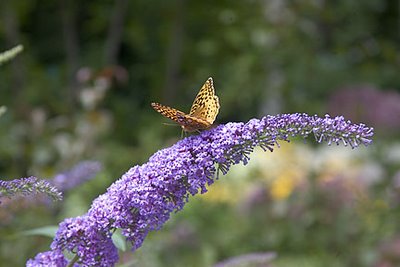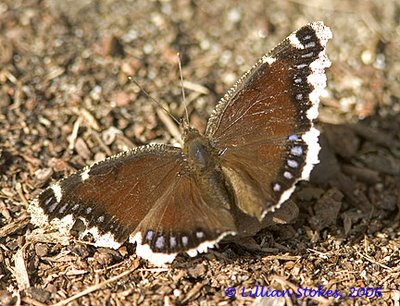Monarch Butterfly. They lay their eggs on milkweed and their caterpillars feed on this plant.

Great Spangled Frittillary on Purple Coneflower

Close-up of Great Spangled Fritillary
American Lady Butterfly, told by the two eye spots on underside of the hindwing
Tiger Swallowtail Butterflies are unmistakable
Spicebush Swallowtails can be told from other big, dark swallowtails by their single row of prominent white dots inside the margin of their forewings. The larvae of Spicebush Swallowtails feed on spicebush and sassafrass.

Pearl Crescent butterfly. Scores are feeding on white clover on our path so we keep the path mowed high to preserve the clover flowers for them.
Mourning Cloaks are widespread across much of North America. They are one of the few butterflies who overwinter as adults, finding protected places in log piles, nooks, or under loose bark, and when they emerge in the spring they look worn, as this butterfly does. They are one of the longest lived butterflies and some may live as long as 10 months. Mourning Cloaks feed on sap and fruit.
 Our butterfly bushes will bloom soon and they're magnets for the butterflies. Check with your local nature society to see which butterfly plants are not invasive in your area. Here's a Great Spangled Fritillary butterfly on butterfly bush.
Our butterfly bushes will bloom soon and they're magnets for the butterflies. Check with your local nature society to see which butterfly plants are not invasive in your area. Here's a Great Spangled Fritillary butterfly on butterfly bush.

We've written two books to help you attract and identify butterflies. Stokes Beginner's Guide To Butterflies, has an easy ID key to help you quickly identify the butterflies you see by size and shape.
 Stokes Butterfly Book gives you plans for a butterfly garden, lists and photos of butterfly plants, and chapters, with color photos, on the identification, behavior and caterpillars of common butterflies. Both are available at amazon.com and stores.
Stokes Butterfly Book gives you plans for a butterfly garden, lists and photos of butterfly plants, and chapters, with color photos, on the identification, behavior and caterpillars of common butterflies. Both are available at amazon.com and stores.
When the birding is slow, and it's the middle of the day, a wonderful thing for birders to do is look for butterflies. Butterflies are colorful flying creatures, just like birds. The identification skills birders already have can be transferred to identifying butterflies.
Look at butterflies through your binoculars, no need to catch them in a net.
The hot weather favors butterflies as they need to warm their bodies to fly. They need to get their body temperature up to 85 to 100 degrees Farenheit in order to fly well. Adult butterflies come to flowers for nectar, lay their eggs on special host plants, which can be unique to each species of butterfly. The eggs hatch, larva feed on the plant then turn into a pupa or crysalis from which the adult butterfly will emerge. A complete cycle or generation is called a brood, and butterfly species can go through from just one to as many as four broods per year, depending on the species and the number of warm months. Different butterflies are on the wing at different times during the summer, so you will continue to see new species.
There are about 17,000 species of butterflies in the world. In North America there are about 700 species but only a small fraction are common and likely to be seen by the average person.
When you see a butterfly watch it closely for several minutes. Observe how it flies, its size, shape, and the colors and patterns on its wings, both above and below.
Start by knowing the major families of butterflies that are distinctive. Below are some:
Swallowtails - are our largest butterflies and most have long tails coming off their hind wings.
Whites and Sulfurs - these are all medium-sized butterflies that are predominantly white or yellow.
Gossamer Wings - this group is easy to identify since it includes all of our smallest butterflies, such as the blues, coppers and hairstreaks, and metalmarks. The blues tend to be iridescent blue, coppers are often copper, hairstreaks often have hairlike tails on their hind wings, and metalmarks often have metallic spots on their wings.
Brush-footed Butterflies - this is a large and varied group of medium-sized, generally dark-colored butterflies with such strong and rapid flight they are hard to follow. Their is no one field characteristic, besides their flight, that makes them easy to identify as a group.
Satyrs - these are medium-sized butterflies that are almost all brown, often with darker eye-spots on their wings. They have a weak and bobbing flight and are often seen at woods edges or among grasses.
Skippers - are small butterflies whose flight is extremely rapid and erratic. They are mostly rich brown or orange-brown.



















